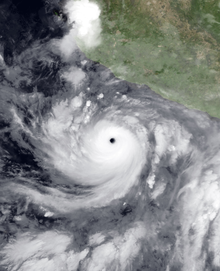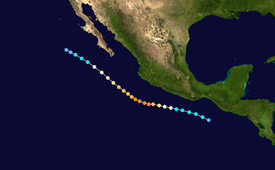 Hurricane Carlotta after peak intensity on June 21 Hurricane Carlotta after peak intensity on June 21 | |
| Meteorological history | |
|---|---|
| Formed | June 18, 2000 (2000-06-18) |
| Dissipated | June 25, 2000 (2000-06-26) |
| Category 4 major hurricane | |
| 1-minute sustained (SSHWS/NWS) | |
| Highest winds | 155 mph (250 km/h) |
| Lowest pressure | 932 mbar (hPa); 27.52 inHg |
| Overall effects | |
| Fatalities | 18 direct |
| Damage | Minimal |
| Areas affected | Mexico |
| IBTrACS | |
Part of the 2000 Pacific hurricane season | |
Hurricane Carlotta was the most powerful hurricane of the 2000 Pacific hurricane season. The third tropical cyclone of the season, Carlotta developed from a tropical wave on June 18 about 270 miles (430 km) southeast off the coast of Mexico. With favorable conditions for development, it strengthened steadily at first, followed by a period of rapid deepening to peak winds of 155 mph (249 km/h) on June 22. Cooler waters caused Carlotta to gradually weaken, and on June 25 it degenerated into a remnant area of low pressure while located about 260 miles (420 km) west-southwest of Cabo San Lucas.
The hurricane produced heavy rainfall and rough surf along the southwest coast of Mexico, though no serious damage was reported. A Lithuanian freighter traversing through the peak of the hurricane was lost after experiencing an engine failure; its crew of 18 was presumed killed.
Meteorological history

Map key Saffir–Simpson scale Tropical depression (≤38 mph, ≤62 km/h)
Tropical storm (39–73 mph, 63–118 km/h)
Category 1 (74–95 mph, 119–153 km/h)
Category 2 (96–110 mph, 154–177 km/h)
Category 3 (111–129 mph, 178–208 km/h)
Category 4 (130–156 mph, 209–251 km/h)
Category 5 (≥157 mph, ≥252 km/h)
Unknown Storm type
 Tropical cyclone
Tropical cyclone  Subtropical cyclone
Subtropical cyclone  Extratropical cyclone, remnant low, tropical disturbance, or monsoon depression
Extratropical cyclone, remnant low, tropical disturbance, or monsoon depression A tropical wave moved off the coast of Africa on June 3. It tracked westward across the unfavorable Atlantic Ocean, and on June 15 it crossed Central America into the eastern Pacific Ocean. The system continued westward, and late on June 16 a low pressure area developed about 300 miles (480 km) southwest of San José, Costa Rica. At around 1200 UTC on June 17, Dvorak classifications began on the disturbance, though initially its convection was broadly distributed and disorganized. The next day, however, an area of concentrated convection developed just south of the Gulf of Tehuantepec. Ships in the vicinity confirmed the development of a surface circulation within the system, while satellite imagery showed the development of a central dense overcast. Based on its organization, it is estimated the system developed into Tropical Depression Three-E late on June 18 while located about 270 miles (430 km) southeast of Puerto Angel, Oaxaca in Mexico.
Initially, the convection of the depression was displaced to the west of the circulation due to some easterly wind shear, though as it tracked west-northwestward parallel to the coast of Mexico, it maintained and developed deep convection near and over the center. With favorable conditions, the cyclone strengthened and became Tropical Storm Carlotta early on June 19. The storm initially maintained a track toward the Mexican coastline, though a mid-level ridge turned it to the west; its closest point of approach was about 140 miles (230 km) at 1200 UTC on June 19. Late that day, a ragged banding-eye feature developed on satellite imagery, while at the same time it maintained an area of strong convection and well-defined outflow to its south. The storm continued to intensify, and at 0600 UTC on June 20 Carlotta attained hurricane status while located about 155 miles (249 km) south of Acapulco. Operationally, it was upgraded to hurricane status six hours earlier.
With a large anticyclone centered near Mazatlán, Sinaloa, Carlotta turned more to the west. Deep convection increased in coverage and intensity as the system maintained impressive upper-level outflow over its southern semicircle. Late on June 20, Hurricane Carlotta began a period of rapid deepening, with warm waters and a very favorable upper-level environment, and in a twelve-hour period the pressure dropped 49 mbar to an estimated minimum central pressure of 932 mbar at 0600 UTC on June 21; at the same time, Carlotta attained peak winds of 155 mph (249 km/h) while located about 285 miles (459 km) southwest of Acapulco. At the time of its peak intensity, Carlotta maintained a well-defined central dense overcast around an eye of 20 miles (32 km) in diameter. Satellite intensity estimates indicated winds of 160 mph (260 km/h), though through much of its duration there was a sizable discrepancy between the estimated winds and that of winds reported by Hurricane Hunters.
Hurricane Carlotta maintained peak winds for about twelve hours before weakening as it curved around the periphery of the mid-level ridge over Mexico. Late on June 21, the eye had become less distinct while its surrounding ring of convection eroded and warmed. Early on June 22, northeasterly wind shear increased, and shortly thereafter the weakening trend was temporarily halted with some oscillations in the convective intensity and eye definition. Weakening continued on June 23 as the hurricane tracked over increasingly cooler waters, and shortly after 0000 UTC on June 24 Carlotta weakened to a tropical storm about 260 miles (420 km) west-southwest of Cabo San Lucas. Overall convection continued to diminish, and early on June 25 the winds dropped to tropical depression status. Deep convection ceased to exist by 0600 UTC on June 25, and Carlotta degenerated into a remnant low pressure area. The low-level circulation of Carlotta persisted for several days as it continued northwestward.
Impact

Shortly after first developing, the government of Mexico issued a tropical storm warning from Salina Cruz to Acapulco, and later was extended to Zihuatanejo. Though the National Hurricane Center never forecast it to make landfall, one computer model predicted Carlotta to move ashore; due to the threat, the Mexican government also issued a hurricane watch from Puerto Angel to Zihuatanejo. Outer rainbands and rough surf affected the southwestern coast of Mexico for an extended duration; officials evacuated about 100 families in potentially flooded areas of Acapulco as a precaution. Precipitation and clouds were reported in every Mexican state along the Pacific Ocean, resulting in flooding in some areas. No stations in Mexico reported sustained tropical storm force winds; however, Bahías de Huatulco International Airport in Oaxaca reported a wind gust of 44 mph (71 km/h). Heavy rainfall and rough seas were also reported on Socorro Island.
Seven ships reported tropical storm force winds in association with Carlotta, peaking at 46 mph (74 km/h); the lowest pressure recorded by ship was 1,008 mbar. Offshore, waves reached 40 feet (12 m) in height. The Lithuanian freighter Linkuva, en route to Long Beach, California, encountered the waves and strong winds as the hurricane was undergoing its period of rapid intensification. After an engine failure, the freighter was lost about 220 miles (350 km) southwest of Acapulco. A naval vessel from both the United States Navy and the Mexican Navy searched for the freighter for three days, though the crew was lost and presumed killed.
See also
References
- ^ James Franklin (2000). "Hurricane Carlotta Tropical Cyclone Report". National Hurricane Center. Retrieved 2007-07-11.
- Miles Lawrence (2000). "Tropical Depression Three-E Discussion One". National Hurricane Center. Retrieved 2007-07-11.
- James Franklin (2000). "Tropical Storm Carlotta Discussion Two". National Hurricane Center. Retrieved 2007-07-13.
- Stacy Stewart & Miles Lawrence (2000). "Tropical Storm Carlotta Discussion Five". National Hurricane Center. Retrieved 2007-07-13.
- James Franklin (2000). "Hurricane Carlotta Special Discussion Six". National Hurricane Center. Retrieved 2007-07-13.
- Jack Beven (2000). "Hurricane Carlotta Discussion Eight". National Hurricane Center. Retrieved 2007-07-15.
- ^ Jack Beven (2000). "Hurricane Carlotta Discussion Twelve". National Hurricane Center. Retrieved 2007-07-15.
- Lixion Avila (2000). "Hurricane Carlotta Discussion Fourteen". National Hurricane Center. Retrieved 2007-07-15.
- James Franklin (2000). "Hurricane Carlotta Discussion Fifteen". National Hurricane Center. Retrieved 2007-07-15.
- Avila (2000). "Hurricane Carlotta Discussion Thirteen". National Hurricane Center. Retrieved 2007-07-15.
- "Hurricane Carlotta forms off Mexico's Pacific coast". Associated Press. 2000-06-19. Archived from the original on 2014-06-10. Retrieved 2014-01-03.
- ^ Alberto Hernández Unzón (2000). "Huracán Carlotta" (in Spanish). Servicio Meteorológico Nacional. Archived from the original on 2007-06-25. Retrieved 2007-07-15.
- National Climatic Data Center (2000). "Climate-Watch, June 2000". Retrieved 2007-07-15.
- ^ CNN.com (2000-06-23). "Freighter disappears off Mexico, 18 missing". Archived from the original on 2013-01-19. Retrieved 2007-07-15.
{{cite news}}:|author=has generic name (help) - Lawrence; et al. (2007). "2000 Eastern Pacific Hurricane Summary". National Hurricane Center. Retrieved 2007-07-15.
| Tropical cyclones of the 2000 Pacific hurricane season | ||
|---|---|---|
 | 2Aletta TSBud 4Carlotta TDFour-E TDFive-E TSUpana 3Daniel TSEmilia TSFabio 1Gilma 1Hector TSIleana TSWene TSJohn TSKristy 2Lane TSMiriam TSNorman TSOlivia TSPaul TSRosa | |
Categories: